Introduction
Known as the “Garden Island” of Fiji, Taveuni Island is a breathtaking destination filled with waterfalls, rainforests, coral reefs, and rich cultural traditions. Unlike the more commercialized islands in Fiji, Taveuni remains largely untouched, offering travelers a unique blend of natural beauty and authentic local experiences. With its dramatic landscapes, incredible biodiversity, and welcoming people, the island has become a paradise for eco-travelers, divers, and those seeking a genuine connection with nature.
This guide explores everything Taveuni has to offer—from its geography and history to its top attractions, outdoor adventures, and cultural encounters—helping you discover why this island is one of Fiji’s most captivating gems.
Geography and Natural Beauty of Taveuni Island
Taveuni is Fiji’s third-largest island, located in the northern part of the archipelago. Stretching about 42 kilometers in length and 11 kilometers in width, it offers a diverse mix of scenery—rugged coastlines, tranquil beaches, volcanic peaks, and dense forests.
The island’s volcanic origins have left behind fertile soils that support lush vegetation and vibrant plant life. Towering coconut palms, tropical fruit trees, and countless species of flowering plants thrive here, giving the island its nickname as the Garden Island. One of the most remarkable natural treasures found only on Taveuni is the Tagimoucia flower, Fiji’s national bloom, which grows near the highland lake of the same name.
The climate is tropical year-round, with average temperatures between 24°C and 30°C. Heavy rainfall during the wet season (November–April) keeps the forests green and the waterfalls flowing, while the dry season (May–October) offers ideal conditions for hiking, diving, and sightseeing.
On the island’s eastern side, the Pacific Ocean creates dramatic cliffs and strong surf, while the western coast features calm waters and rich coral reefs. This contrast makes Taveuni a perfect balance between adventure and relaxation, appealing to hikers, divers, and beach lovers alike.
History and Cultural Background
Beyond its natural wonders, Taveuni Island has a deep cultural and historical identity. Indigenous Fijians have lived here for centuries, preserving traditions and oral histories that continue to shape island life today.
In the past, Taveuni was a stronghold of tribal communities, each led by chiefs who governed with customary practices. During the 19th century, missionaries introduced Christianity, which blended with local traditions, while European settlers established coconut plantations. Despite these influences, the people of Taveuni have held on to their cultural heritage, making it one of the best places in Fiji to experience authentic village life.
Visitors often participate in a sevusevu ceremony, where kava root is presented to the village chief as a sign of respect. In return, guests are welcomed to join in dances, storytelling, and feasts. Local legends also add to the island’s charm—for example, the story of the Tagimoucia flower, believed to have bloomed from the tears of a heartbroken princess.
Today, Taveuni is celebrated not just for its landscapes but also for the warmth and hospitality of its people, who proudly share their culture with travelers.
How to Reach
Reaching Taveuni may require some planning, but the journey is part of the adventure.
By Air
The quickest way to reach the island is by air. Regular flights operate from Nadi International Airport and Suva to Matei Airport in northern Taveuni. The 90-minute flight offers stunning views of Fiji’s islands and coral reefs, making it a scenic start to your journey.
By Sea
Travelers can also reach Taveuni by ferry from Vanua Levu, Fiji’s second-largest island. Boats depart from Savusavu or Buca Bay and arrive at Waiyevo or other coastal points on Taveuni. Though slower, sea travel offers a more immersive experience and is generally more affordable.
Getting Around
Once on the island, transportation options include taxis, rental cars, and buses that run along the main coastal road. Many resorts also provide transfers for their guests. Adventurous travelers may enjoy using local buses, which stop at villages along the way and give a glimpse of everyday island life. For day trips to nearby islands such as Qamea or Matagi, small boats and resort-organized tours are readily available.
Top Tourist Attractions
Taveuni is packed with natural and cultural attractions, ranging from rainforest hikes to unique landmarks.
Bouma National Heritage Park
Covering more than 150 square kilometers, Bouma National Heritage Park is one of the island’s top highlights. Managed by local communities, the park preserves waterfalls, tropical rainforests, and rare wildlife.
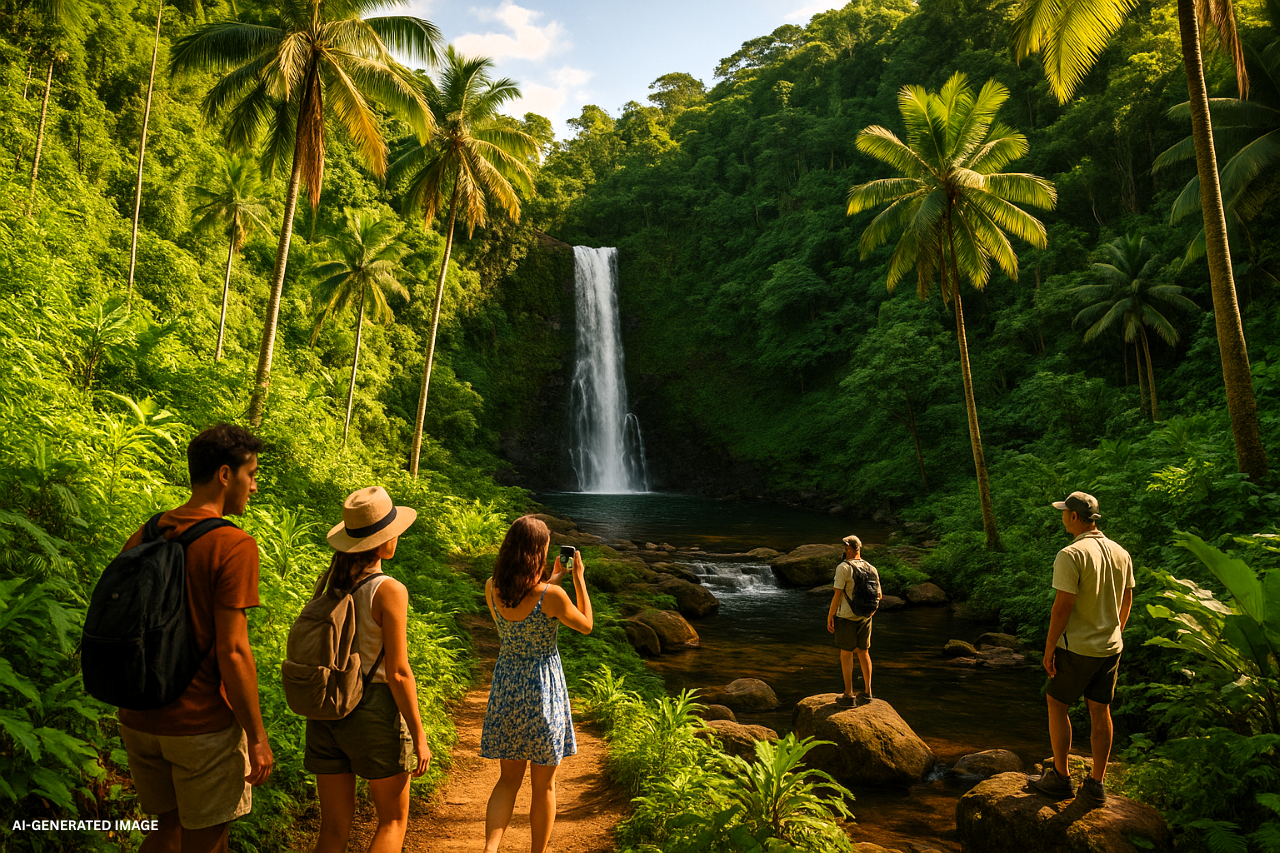
The famous Tavoro Waterfalls—a three-tiered cascade—are the park’s centerpiece. The first fall is easily accessible and perfect for swimming, while the second and third require longer hikes, rewarding visitors with peaceful pools and spectacular views.
The park is also a haven for birdwatchers, home to species such as the orange dove and silktail. With trails for both casual walkers and seasoned trekkers, Bouma is a must-visit destination for anyone exploring Taveuni Island.
Lavena Coastal Walk
The Lavena Coastal Walk is one of the most scenic hikes on Taveuni Island, offering a combination of natural beauty and cultural encounters. The trail, which begins in Lavena village, extends for approximately 5 kilometers along the island’s eastern coastline and is managed by the local community. Entry fees help support village development, making this a successful example of community-based tourism.
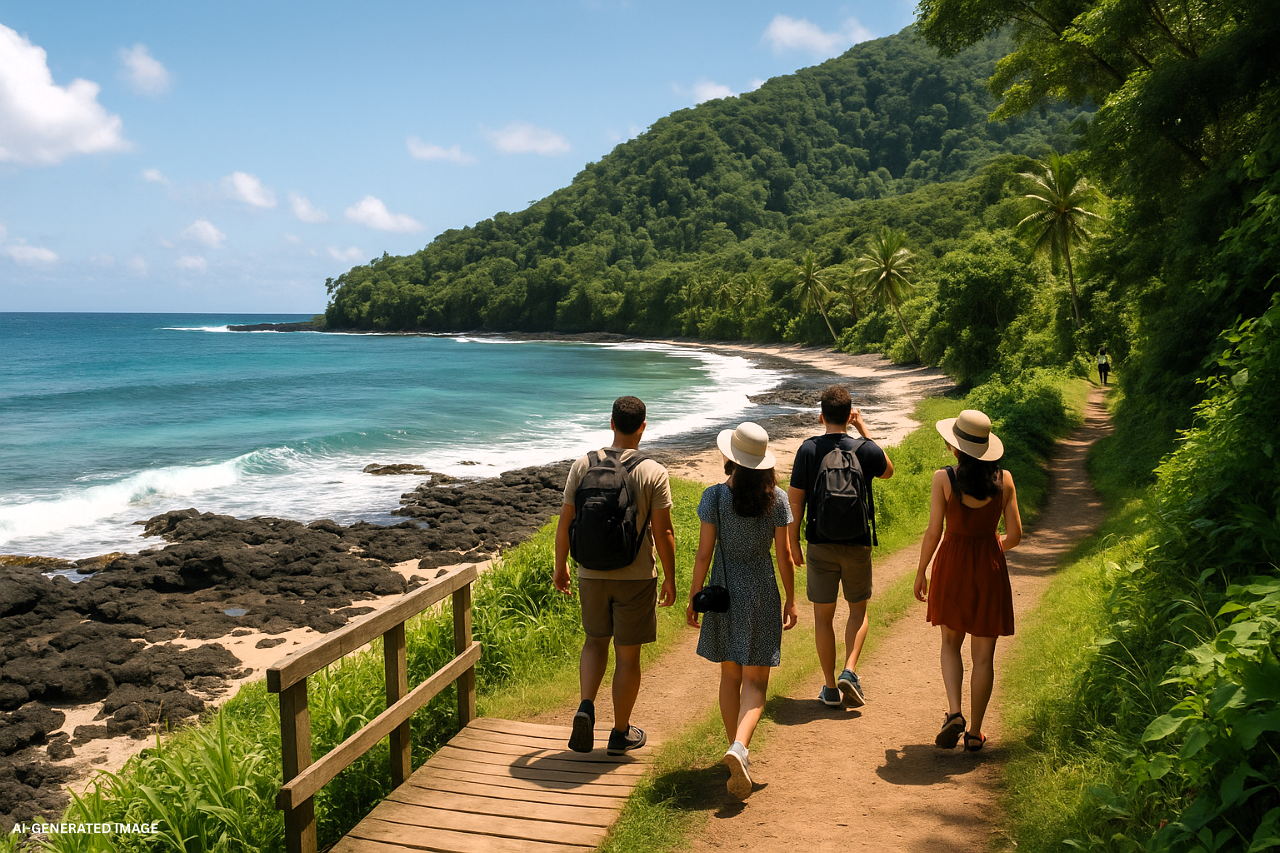
As you follow the trail, you’ll encounter a mix of black- and white-sand beaches, mangroves, streams, and lush rainforest. The walk culminates in a spectacular reward—a twin waterfall that plunges into a natural swimming pool, perfect for cooling off after the trek. Along the way, travelers often spot native birds and unique plants, adding to the sense of immersion in nature.
What makes this experience truly memorable is not just the scenery but also the interaction with villagers, who maintain the trail and welcome visitors warmly. It’s a hike that blends adventure, relaxation, and cultural appreciation.
Waitavala Waterslides
For a playful and unique experience, head to the Waitavala Waterslides, located near Waiyevo. Over time, flowing water has smoothed volcanic rock formations into natural slides, creating a fun attraction for both children and adults.
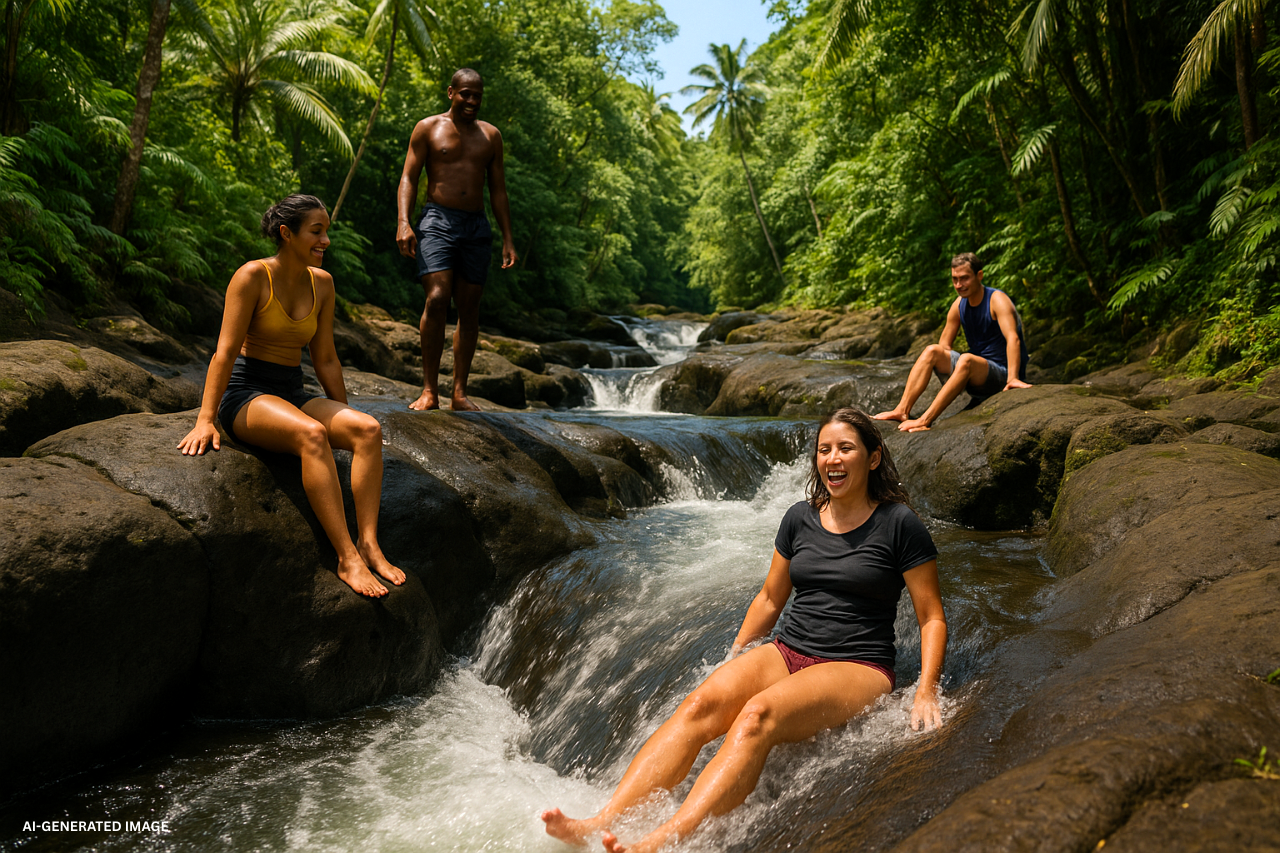
Residents often gather here, and you may see young people demonstrating the best way to glide down the rocks safely. The slides end in clear, refreshing pools, making it an enjoyable stop on a hot day.
Set against a backdrop of lush greenery, the Waitavala Waterslides provide not only entertainment but also a chance to experience how islanders enjoy their natural surroundings.
Lake Tagimoucia
Perched high in the mountains is the enchanting Lake Tagimoucia, a crater lake renowned for being the only place in the world where the rare Tagimoucia flower grows. This striking red-and-white blossom, Fiji’s national flower, holds cultural and symbolic significance.
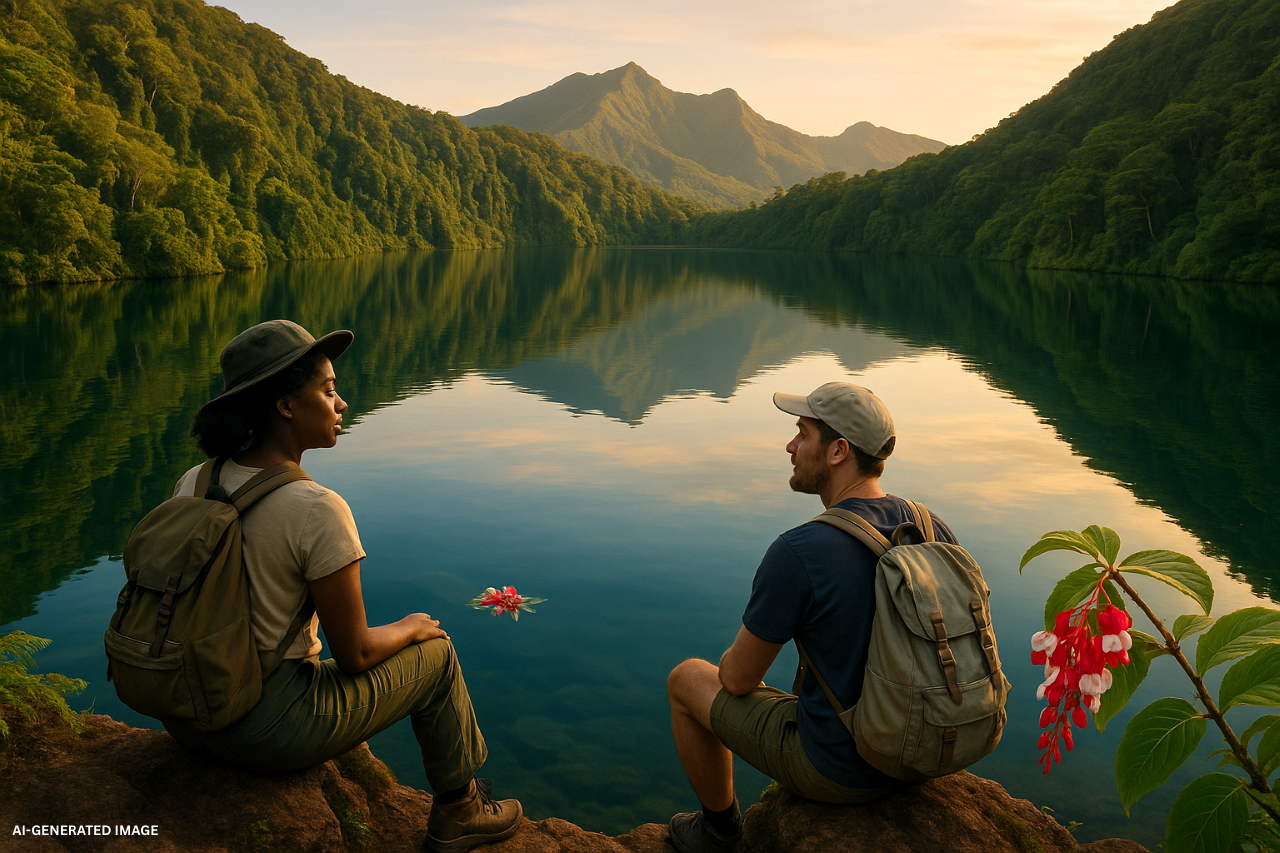
According to local legend, the flower sprang from the tears of a young princess who fled into the mountains, giving the lake a mythical aura.
Reaching Lake Tagimoucia requires a challenging hike through rainforest terrain, but those who make the journey are rewarded with views of a serene alpine lake surrounded by lush vegetation. For adventurous travelers, it is one of the most unforgettable experiences on the island.
International Dateline
One of Taveuni Island’s unique features is its location on the 180th meridian, which marks the International Dateline. This line separates two calendar days, allowing visitors to stand with one foot in “yesterday” and the other in “today.”
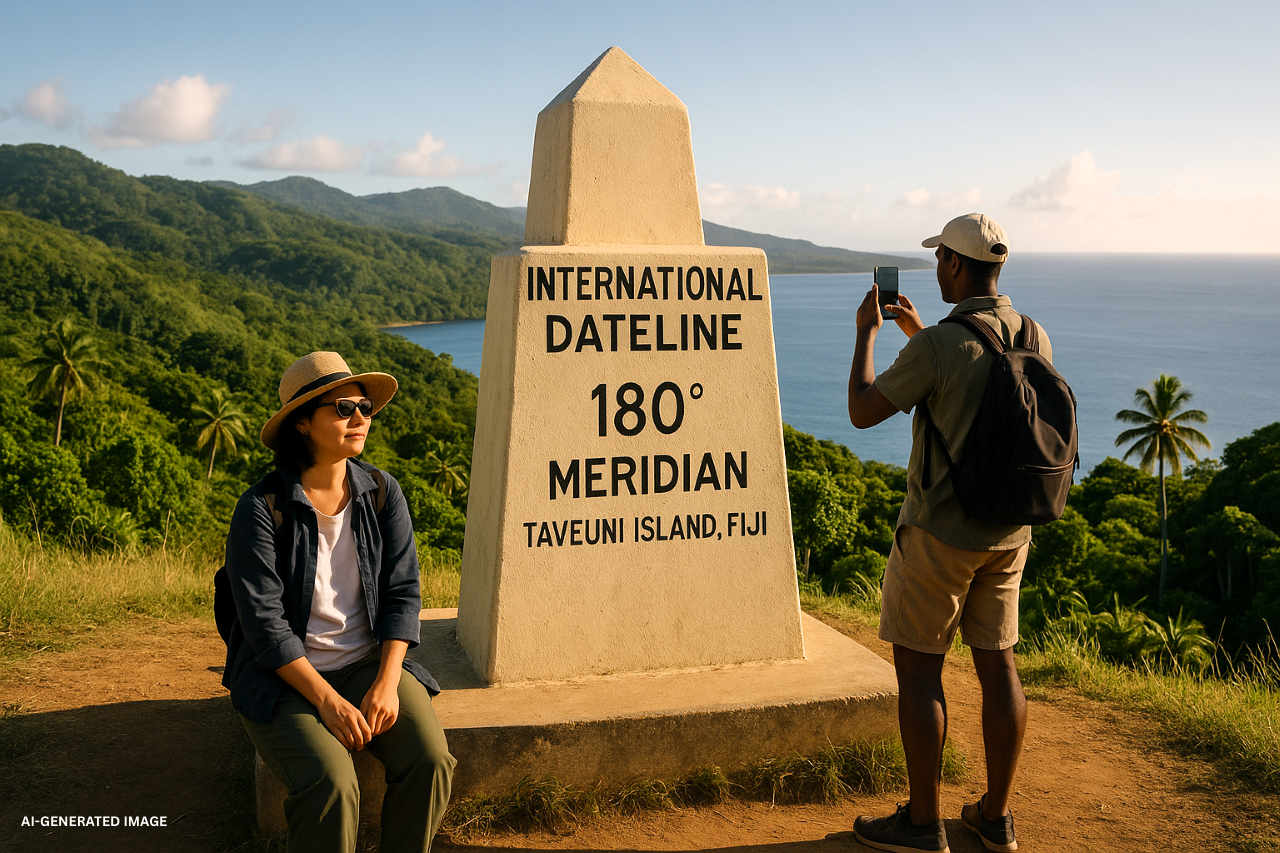
A small marker near Waiyevo identifies the spot. While it may not be as dramatic as the island’s waterfalls or reefs, it offers an intriguing photo opportunity and a fun stop for those who enjoy unusual landmarks.
Qamea and Matagi Islands (Day Trips)
Just off Taveuni’s coast are Qamea and Matagi Islands, two idyllic destinations perfect for day trips.
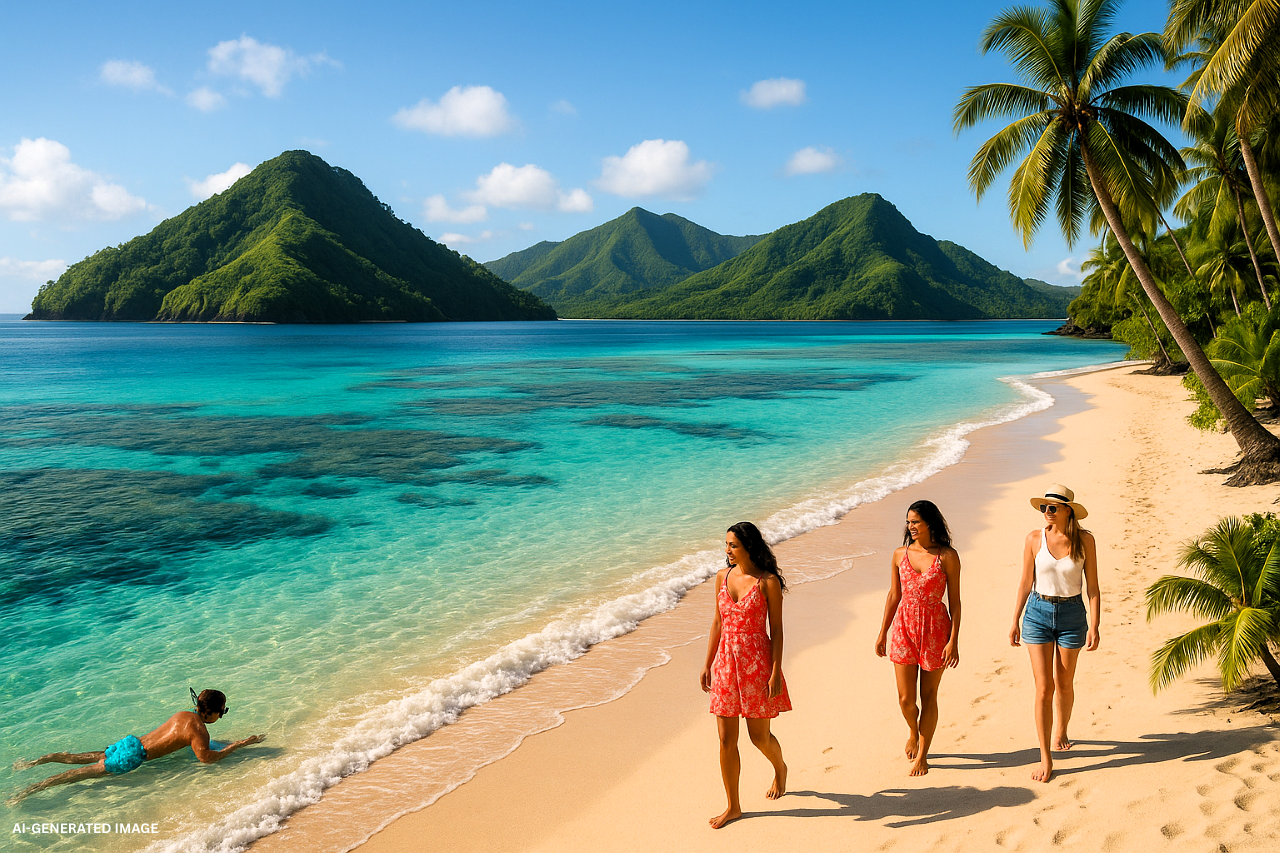
-
Qamea Island is known for its quiet beaches, excellent snorkeling, and relaxed atmosphere. With only a few boutique resorts, it’s a favorite spot for couples and travelers seeking peace and privacy.
-
Matagi Island, shaped like a horseshoe, is often described as one of the most picturesque islands in Fiji. It is privately owned and home to an exclusive resort, but day visits can be arranged. Its coral gardens and pristine waters are excellent for snorkeling and diving.
Both islands offer travelers the chance to escape into tranquil surroundings while still staying close to the attractions of Taveuni.
Adventure and Outdoor Activities
For adventure seekers, Taveuni Island offers endless opportunities to explore both land and sea.
Hiking and Trekking
The island features trails suitable for all fitness levels, from short village walks to more strenuous rainforest treks. Popular routes include the Lavena Coastal Walk and the paths in Bouma National Heritage Park, which showcase waterfalls, beaches, and lush ecosystems. For those wanting a challenge, longer hikes lead into the mountainous interior.
Birdwatching and Wildlife
Taveuni is one of Fiji’s top birdwatching locations. Endemic species such as the orange dove, the elusive silktail, and the colorful red shining parrot can all be spotted here. Early mornings are particularly rewarding, and guided tours help visitors maximize their chances of sightings.
Water Sports
The island’s bays and lagoons are perfect for kayaking and paddleboarding. Gliding across calm, crystal-clear waters offers a different perspective of the coastline, with views of palm-lined beaches and volcanic cliffs.
Photography
With its dramatic landscapes, cascading waterfalls, and vibrant reefs, Taveuni is a paradise for photographers. Cultural experiences, such as village ceremonies, also provide striking subjects. Sunrise and sunset along the coastline add even more opportunities for breathtaking photos.
Diving and Snorkeling
For lovers of the ocean, Taveuni Island is a dream destination. Located along the Somosomo Strait, the island is surrounded by some of the most vibrant and diverse marine ecosystems in the South Pacific. Often referred to as the “Soft Coral Capital of the World,” Taveuni is a magnet for divers and snorkelers alike.
Rainbow Reef
The most iconic site is the Rainbow Reef, which stretches across the Somosomo Strait between Taveuni and Vanua Levu. True to its name, the reef is covered in soft corals that glow in every shade imaginable. Schools of tropical fish dart among the coral, while larger creatures such as reef sharks, turtles, and barracuda cruise the deeper waters. Nutrient-rich currents keep the reef healthy and ensure excellent visibility for divers year-round.
The Great White Wall
Perhaps the most legendary dive site in Fiji, the Great White Wall lies within Rainbow Reef. Divers enter through an underwater tunnel that opens onto a sheer drop-off blanketed with thousands of glowing white soft corals. When sunlight penetrates the water, the entire wall shimmers like a snowy cliff beneath the sea—an experience many divers describe as otherworldly.
Snorkeling Opportunities
For those who prefer snorkeling, Taveuni offers equally rewarding experiences. Many resorts have direct access to coral gardens just offshore, while organized trips to nearby Qamea and Matagi Islands provide opportunities to swim alongside parrotfish, butterflyfish, and even sea turtles.
Protecting the Reefs
Conservation is a priority in Taveuni. Local communities and dive operators collaborate to establish marine reserves and no-fishing zones. Visitors are encouraged to use reef-safe sunscreen and follow eco-friendly guidelines to help preserve these delicate ecosystems.
Flora and Fauna of Taveuni
Taveuni’s nickname, the Garden Island, is well deserved. Its fertile volcanic soils, high rainfall, and tropical climate nurture an astonishing variety of plants and animals.
Flora
The island’s rainforests are rich in biodiversity, with orchids, giant ferns, and towering palms dominating the landscape. The most famous plant is the Tagimoucia flower, a striking red-and-white blossom that grows only near Lake Tagimoucia. Coconut palms, breadfruit, and banana trees thrive across the island, providing food and shade for villages.
Fauna
Birdwatchers are particularly drawn to Taveuni, as the island is home to several endemic species. The brilliant orange dove, the delicate silktail, and the vibrant red shining parrot are among the highlights.
Reptiles such as geckos and skinks are common, while frogs inhabit the wetter areas. Offshore, the surrounding waters provide a haven for dolphins, sea turtles, and occasionally manta rays, adding to the island’s ecological richness.
Conservation Efforts
Conservation is integral to island life. Many villages reinvest tourism income into environmental protection, ensuring that Taveuni’s forests and wildlife remain unspoiled for future generations.
Local Villages and Cultural Encounters
While its natural beauty is remarkable, the cultural experiences on Taveuni Island are equally memorable. Visiting local villages gives travelers an authentic understanding of Fijian life and traditions.
Village Visits
Guests are welcomed with a sevusevu ceremony, where visitors present kava root to the chief as a symbol of respect. Once accepted, travelers are invited to join in feasts, dances, and storytelling sessions, creating meaningful connections with the community.
Kava Ceremony
Central to Fijian social life is the kava ceremony. Kava, prepared from the root of the yaqona plant, is mixed with water and shared among participants. While mildly sedative, it is primarily valued for its role in bringing people together and honoring important occasions.
Crafts and Traditions
Villages often showcase handwoven mats, tapa cloth, and wood carvings. Purchasing directly from artisans supports local families and helps preserve traditional skills. Cultural performances such as the meke, which combines song, dance, and storytelling, provide a deeper appreciation of Fiji’s heritage.
Respectful Tourism
When visiting villages, modest clothing, removing hats, and asking permission before taking photos are essential signs of respect. These gestures show appreciation for local customs and strengthen the bond between travelers and hosts.
Resorts and Accommodation Options
From luxury resorts to simple homestays, Taveuni Island offers accommodations that cater to all types of travelers. Most places emphasize sustainability and harmony with nature rather than mass tourism.
Luxury Resorts
High-end resorts provide private villas, infinity pools, spa services, and fine dining, often set on secluded beaches or cliffs with sweeping ocean views. They are especially popular with honeymooners and those seeking a romantic escape.
Eco-Lodges and Mid-Range Stays
Eco-lodges combine comfort with sustainability, using solar power, rainwater collection, and eco-conscious designs. Mid-range hotels and guesthouses are cozy and affordable, offering easy access to the island’s main attractions.
Budget Options and Homestays
Travelers on a budget can find welcoming guesthouses and homestays. Staying with a local family allows for cultural immersion, with home-cooked meals and the chance to learn about everyday island life.
Best Areas to Stay
-
Matei –
-
Conveniently near the airport and home to several resorts and cafés.
-
Waiyevo –
-
A good base for exploring cultural and historical landmarks, including the International Dateline marker.
-
Remote eco-lodges –
-
Perfect for those seeking solitude and immersion in untouched rainforest or coastline.
Local Cuisine and Dining Experiences
A journey to Taveuni Island is not complete without sampling its rich and flavorful cuisine. Fijian food is a reflection of its tropical environment and cultural traditions, with fresh seafood, root vegetables, and coconut forming the foundation of most meals.
Traditional Favorites
One of the most iconic dishes is lovo, a feast cooked in an underground earth oven. Meat, fish, and vegetables such as taro and cassava are wrapped in banana leaves and slow-cooked over heated stones, resulting in smoky, tender flavors.
Another must-try is kokoda, Fiji’s take on ceviche. Fresh fish is marinated in lime juice, then mixed with coconut cream, onions, tomatoes, and chilies. Light and refreshing, it’s the perfect dish for the island’s warm climate.
Everyday Staples
Crops like cassava, yams, and taro are staples in the local diet. Coconut is used extensively in both savory dishes and desserts, while tropical fruits such as papaya, pineapple, and bananas are enjoyed daily.
Dining Options
Most resorts on Taveuni feature in-house restaurants offering a blend of traditional Fijian dishes and international cuisine. In Matei, smaller cafés and eateries provide affordable meals and freshly made fruit smoothies, ideal for travelers looking for a casual dining experience.
The Social Side of Food
Dining in Fiji is often a communal experience. Meals are shared, emphasizing hospitality and togetherness. Joining a lovo in a village or sharing a meal with locals offers a genuine taste of island life.
Festivals and Events
Festivals and events in Taveuni highlight the island’s strong sense of community and cultural pride.
Religious Celebrations
Christianity plays a central role in daily life, and celebrations such as Christmas and Easter are marked with church services, feasting, and music. Visitors are often welcome at church gatherings, where powerful choir performances create unforgettable experiences.
Cultural Gatherings
During traditional events, villagers perform the meke, a combination of song, dance, and storytelling. These performances preserve Fijian history and legends while entertaining guests.
Seasonal Fairs
Community fairs and harvest celebrations occasionally take place, offering a chance to sample local foods, watch cultural displays, and mingle with residents.
Sustainable and Eco-Tourism
Sustainability is a defining feature of tourism on Taveuni Island, with initiatives that protect the environment while supporting local communities.
Community-Managed Attractions
Sites such as the Lavena Coastal Walk and Bouma National Heritage Park are operated by local villages. Visitor fees go directly into funding community projects, ensuring tourism benefits residents.
Eco-Friendly Stays
Many of the island’s lodges and resorts follow eco-conscious practices, including solar energy use, rainwater harvesting, and waste reduction. Guests are encouraged to adopt sustainable habits during their stay.
Marine and Forest Protection
Marine reserves and no-fishing zones safeguard coral reefs, while reforestation efforts protect rainforest ecosystems. Visitors are urged to use reef-safe sunscreen and follow guidelines that minimize their environmental impact.
Volunteering Opportunities
Some organizations on the island welcome volunteers to support conservation projects such as coral monitoring, wildlife protection, and tree planting. This allows travelers to contribute to the island’s sustainability efforts while enjoying its natural beauty.
Practical Travel Tips
Planning ensures a smooth and rewarding trip to Taveuni.
Best Time to Visit
The dry season (May–October) is best for outdoor adventures, with cooler temperatures and less rain. The wet season (November–April) brings heavy rainfall but makes the waterfalls more dramatic and the forests more vibrant.
Packing Essentials
-
Lightweight tropical clothing and swimwear
-
Comfortable hiking shoes
-
Reef-safe sunscreen and insect repellent
-
A waterproof bag for valuables
-
Snorkeling gear (if preferred)
Safety and Health
Taveuni is generally very safe, with friendly and welcoming communities. Mosquito repellent is essential, especially in the wet season. Medical facilities are basic, so travelers should bring personal medications.
Money and Connectivity
The local currency is the Fijian dollar. While most resorts accept credit cards, cash is useful in villages and small shops. Internet service is available but can be slow in remote areas, providing the perfect opportunity to unplug.
Suggested Itineraries for Taveuni Island
3-Day Itinerary
-
Day 1:
-
Explore Matei, relax on the beach, and snorkel at nearby reefs.
-
Day 2:
-
Visit Bouma National Heritage Park and swim at the Tavoro Waterfalls.
-
Day 3:
-
Take the Lavena Coastal Walk before departure.
5-Day Itinerary
-
Day 1:
-
Arrive in Matei, visit Waiyevo, and stop at the International Dateline marker.
-
Day 2:
-
Hike to Lake Tagimoucia.
-
Day 3:
-
Dive or snorkel at Rainbow Reef.
-
Day 4:
-
Join a sevusevu ceremony in a local village.
-
Day 5:
-
Enjoy a day trip to Qamea or Matagi Island.
7-Day Itinerary
-
Days 1–2:
-
Explore Bouma National Heritage Park and Lavena Coastal Walk.
-
Day 3:
-
Dive the Great White Wall.
-
Day 4:
-
Trek to Lake Tagimoucia.
-
Day 5:
-
Experience Waitavala Waterslides and visit nearby villages.
-
Day 6:
-
Take a boat trip to Matagi Island.
-
Day 7:
-
Relax with beachside dining and shop for local crafts.
Conclusion
Taveuni Island truly deserves its reputation as Fiji’s Garden Island. With its rainforests, waterfalls, rare Tagimoucia flower, colorful reefs, and welcoming villages, it offers a travel experience that is both adventurous and deeply cultural. Unlike busier islands, Taveuni provides a slower, more authentic way to experience Fiji—perfect for travelers who want to connect with both people and nature.
Whether you’re diving at Rainbow Reef, hiking through Bouma National Heritage Park, or sharing a lovo meal in a village, Taveuni offers memories that last a lifetime.
FAQs
Why is Taveuni called the “Garden Island”?
Because of its lush rainforests, fertile volcanic soil, and abundance of tropical plants.
When is the best time to visit Taveuni?
May to October, when the weather is drier and cooler, although the wet season is greener and less crowded.
How many days should I spend on the island?
Three to five days is enough for highlights, but a week allows for full immersion.
Is Taveuni good for diving?
Yes, it’s world-famous for Rainbow Reef and the Great White Wall.
Is Taveuni family-friendly?
Yes, families can enjoy the Waitavala Waterslides, easy hikes, snorkeling, and cultural experiences.
How can I reach Lake Tagimoucia?
By hiking through rainforest trails to the crater lake, ideally with a local guide.
What’s special about the International Dateline here?
You can stand on two different calendar days at the same time.
Is Taveuni safe for visitors?
Yes, it is very safe, with warm and hospitable locals.
Are there eco-friendly resorts on the island?
Yes, many lodges follow sustainable practices and support local communities.
What makes Taveuni unique compared to other islands?
Its untouched forests, endemic Tagimoucia flower, authentic culture, and world-class reefs set it apart.
